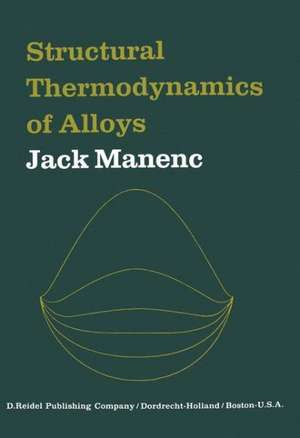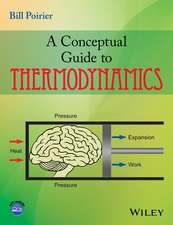Structural Thermodynamics of Alloys
Autor J. Manenc Traducere de N. Corcoranen Limba Engleză Paperback – 11 ian 2012
Preț: 380.25 lei
Nou
Puncte Express: 570
Preț estimativ în valută:
72.77€ • 75.07$ • 61.59£
72.77€ • 75.07$ • 61.59£
Carte tipărită la comandă
Livrare economică 05-19 martie
Preluare comenzi: 021 569.72.76
Specificații
ISBN-13: 9789401026079
ISBN-10: 9401026076
Pagini: 232
Ilustrații: 225 p.
Dimensiuni: 127 x 203 x 12 mm
Greutate: 0.23 kg
Ediția:Softcover reprint of the original 1st ed. 1973
Editura: SPRINGER NETHERLANDS
Colecția Springer
Locul publicării:Dordrecht, Netherlands
ISBN-10: 9401026076
Pagini: 232
Ilustrații: 225 p.
Dimensiuni: 127 x 203 x 12 mm
Greutate: 0.23 kg
Ediția:Softcover reprint of the original 1st ed. 1973
Editura: SPRINGER NETHERLANDS
Colecția Springer
Locul publicării:Dordrecht, Netherlands
Public țintă
ResearchCuprins
General Considerations.- I: Equilibrium States.- 1. Review of Fundamental Concepts of Classical Thermodynamics of Solutions.- 2. Variation of Thermodynamic Functions with Composition at Constant Pressure or Volume and Temperature.- 3. Classification of Different Types of Homogeneous Solution According to Expression of Free Energy.- 4. Experimental Determination of Curves of Activity and of Free Energy.- 5. Conditions for De-mixing of Solutions.- 6. Equilibrium Diagrams.- 7. Statistical Thermodynamics of Solutions.- II: Structure of Alloys not in the Equilibrium State.- 8. Evolution of Structure Towards Equilibrium. Activation Energy.- 9. Hardening by Precipitation.- 10. Thermodynamic Considerations on Formation of Metastable Phases During Ageing of Very Hard Alloys.- 11. Theory of Precipitation.- 12. Growth of Precipitates Formed by Homogeneous Nucleation.- 13. Discontinuous Precipitation.- 14. Martensitic Transformation of Alloys.









